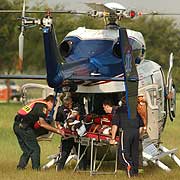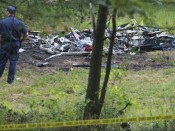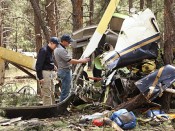By Alan Levin and Robert Davis, USA TODAY
 The helicopter flight to take heart patient Jerry Leonard from one Indiana hospital to another should have been routine.
The helicopter flight to take heart patient Jerry Leonard from one Indiana hospital to another should have been routine.
But on the night of the trip, April 20, 2004, the pilot on the Air Evac Lifeteam air ambulance apparently forgot to adjust the helicopter’s altimeter, federal records show. When he slammed the helicopter carrying Leonard into a hillside near Boonville, Ind., the cockpit gauge showed he was 310 feet off the ground.
“Boy, I screwed up,” pilot Richard Larock told an emergency worker who responded to the crash.
Larock and two medical workers survived, but Leonard — 63 years old and strapped to a gurney — was flung from the helicopter, the stretcher strap forced against his throat. “It took 10 minutes for him to strangle to death,” says his son, Keith Leonard.
The flight that was supposed to help save Leonard’s life killed him instead.
A deadly trend of pilot errors, industry carelessness and poor government oversight has driven the number of air ambulance crashes to record levels. (Related story: Inexperience proves fatal)
Since 2000, 60 people have died in 84 crashes — more than double the number of crashes during the previous five years. During that period, more than 10% of the U.S. air ambulance helicopter fleet crashed. If commercial airlines lost the same proportion of large passenger jets as air ambulance companies lost helicopters, 90 airliners would crash each year.
Despite the surge in the number of crashes, however, air ambulance companies and the federal agency that oversees them failed time and again to take steps that might have averted tragedy and saved lives, a USA TODAY investigation shows.
The newspaper reviewed hundreds of pages of documents and interviewed dozens of pilots, aviation experts, federal officials, and executives with the companies that operate the flights. Because government statistics on air ambulance crashes are sparse, USA TODAY also created its own database of 275 accidents since 1978.
Unlike passengers on commercial jets, the people being transported by air ambulances — many critically ill or injured in accidents far from hospitals — had no choice but to make the flights.
The crashes that killed them often involved egregious errors by pilots and crew. In one case, a helicopter carrying an 11-day-old child and her mother slammed into the side of a mountain at night. In other crashes, pilots flew into thick fog even after other air ambulance pilots had refused to fly.
“This isn’t search and rescue,” says Jamie Lebovitz, the lawyer representing the Leonard family. “This is transport and kill.”
Accident reports by the National Transportation Safety Board read like a horrifying guide for how not to fly.
Among the crashes:
On March 10, 2000, a pilot charged with taking a sick infant to a Texas hospital lifted off in fog so thick that an ambulance driver and others on the ground quickly lost sight of the helicopter. The pilot’s employer, Temsco Helicopters Inc., forbade flying in such conditions, which require instruments to navigate, according to the NTSB. The pilot had only one hour of instrument experience. The helicopter crashed less than a mile away, killing all four people aboard.
On Aug. 26, 2002, medical workers on a Rocky Mountain Helicopters mission fled a burning helicopter after a crash landing without evacuating the patient — a baby with respiratory problems. The pilot had landed on a highway in Bradenton, Fla., after the helicopter’s engine caught fire. The pilot and three medical crewmembers fled. The pilot told investigators that he saw the baby after returning to fight the fire, and he rescued the child.
On July 13, 2004, a Med-Trans Corp. helicopter flew to a highway accident in Newberry, S.C., after three other helicopter companies turned the job down because mist and fog blanketed the area. Seconds after taking off with the patient, the helicopter struck nearby trees and crashed. All four people aboard died.
On Aug. 21, 2004, an Access Air Ambulance flight carrying an 11-day-old infant and her mother to a Reno hospital slammed into a mountainside in a remote area of northern Nevada. The pilot was following a well-traveled route over a mountain range on a moonless night but didn’t climb high enough. All five people aboard died.
On Oct. 20, 2004, a helicopter left Santa Rosa Beach, Fla., to pick up a patient at a hospital in De Funiak Springs, Fla., even though a nearby weather station reported low visibility, according to preliminary findings by the NTSB. The company, Metro Aviation Inc., was not certified to fly in such conditions. After only two minutes, the pilot radioed that he was attempting to return because of bad weather. The helicopter crashed into a bay, killing the pilot and two medical workers.
The newspaper’s investigation found that:
• Industry safeguards are so lax that pilots have repeatedly caused accidents by knowingly flying into bad weather, failing to check weather conditions or otherwise violating federal or company regulations. In at least 17 cases since 1995, pilots crashed after flouting fundamental flight rules. (Related story: Pilots pressure themselves to fly)
• Despite at least nine crashes since 2003 in which a disoriented pilot flew into the ground, federal regulations exempt helicopters from some of the most basic safety standards and equipment required for commercial airlines, including devices that warn pilots when they get too close to the ground.
• Government inspections of air ambulance operations, a process critical to holding companies accountable for safety, are haphazard and inadequate. A draft report by a Federal Aviation Administration task force that studied the crashes last year concluded that inspections are “hit-or-miss” and that some accidents were “partly attributable” to poorly trained inspectors. In three fatal crashes last year, FAA inspectors had never visited helicopter bases to check pilot credentials, maintenance records and other documentation, steps crucial to ensuring safe flight.
Dueling viewpoints
Some medical studies also question the need for many air ambulance flights. A 2002 study in The Journal of Trauma found that helicopters were used “excessively” for patients who weren’t severely injured, and often didn’t get patients to the hospital faster than ground ambulances.
One possible explanation for the alleged overuse: profit. Air ambulance firms receive roughly $7,500 per flight from insurance companies or Medicare.
But industry leaders cite other studies to show that thousands of lives are saved each year by speedy flights to hospitals — far more than are lost in crashes. A study this year in the Air Medical Journal found that states with better air ambulance coverage tended to have lower highway fatality rates. “We do this because there are benefits,” says Tom Judge, president of the Association of Air Medical Services, the industry’s trade group.
Pilots sometimes find themselves in particularly trying situations. Despite darkness or bad weather, they may be summoned to accident scenes. They aren’t supposed to take off in poor conditions, but their decision whether to fly could mean life or death.
“I don’t know anybody in this industry who isn’t dedicated to safety and dedicated to what we do,” says Ron Fergie, president of the National EMS Pilots Association.
FAA and industry officials say they are moving to improve safety. Among the steps: encouraging companies to buy night-vision goggles, which allow pilots to see hazards in the dark, when the majority of crashes occur.
The FAA also has worked with companies to develop procedures to help pilots decide whether to stay on the ground in dangerous conditions. The agency pledges to review safety standards at every air ambulance company this summer. And industry trade groups say many companies are improving training without waiting for mandates by the FAA.
“We take this very seriously,” says Jim Ballough, who oversees the FAA’s safety effort. “The public will see change.”
But in the face of industry concerns about cost, many of the most promising safety enhancements have not been required. Flight regulations have not been rewritten. The FAA hasn’t followed key safety recommendations it received from its own task force last December. And though safety reviews of companies are planned, Ballough concedes the agency still lacks a system to ensure that all air ambulance bases — especially those located far from their companies’ headquarters — are inspected.
In interviews, the FAA offered no explanation for why it failed to act earlier or devote more resources to monitoring the air ambulance industry. But the upswing in crashes occurred as the agency faced growing pressure to tighten oversight of large airlines after the crashes of a ValuJet flight in Florida in 1996 and an Alaska Airlines jet in California in 2000.
The failure to act, by the industry and the government, is “almost criminal,” says Vernon Albert, a former air ambulance company flight director who is now a safety consultant. “Someone needs to be uncomfortable,” Albert says, “and not the guy riding in the back of the helicopter.”
‘We don’t know what happened’
When Jerry Leonard was killed as a result of the Boonville, Ind., crash last year, “it was just like somebody driving a knife through your heart,” Keith Leonard says.
The Leonard family had driven to Deaconess Hospital in Evansville, Ind., to meet Leonard, who was having heart problems. He was being airlifted there from a hospital in Huntingburg, Ind., 40 miles away. Leonard never arrived.
The family “believed that this air ambulance, with a pilot and paramedic and nurse, were going to provide him with state-of-the art care and deliver him safely to a hospital,” says Lebovitz, the family’s lawyer.
“And the company violated that trust. They breached that trust.”
Air Evac declined to comment on the accident, but spokeswoman Julie Heavrin says the company has taken several actions to improve safety, including buying a helicopter flight simulator for training.
Across the industry, however, mistakes by pilots remain the cause of the overwhelming majority of crashes. The newspaper’s analysis of almost 30 years worth of accidents shows that 82% of fatal crashes were caused by human error — almost all by pilots.
In 2000, the air ambulance trade group called on the FAA to push companies to emulate the type of training used by airlines to minimize mistakes. Known at airlines as “Crew Resource Management,” the training teaches pilots to listen to concerns from other crewmembers and to monitor themselves for factors such as fatigue and tension.
In July 2000, an industry committee suggested language for such a training program and sent it to Jane Garvey, the FAA’s administrator at the time, says J. Heffernan, an air ambulance company official who headed the effort.
“We don’t know what happened after that,” Heffernan says.
Some companies went ahead with the training program, but it was never endorsed or addressed by the FAA. Agency spokeswoman Alison Duquette says the FAA found no record that it even received the industry’s recommendations.
No one can say for sure whether the industry’s suggested safety program would have prevented air ambulance crashes if it had been instituted industrywide. But similar programs at airlines are credited with reducing accident rates.
Today, about five years and dozens of crashes after the industry first proposed the safety program, the FAA is preparing to formally endorse it.
A proposal within the FAA to gather more data on how many hours air ambulance firms fly also went nowhere. As a consequence, tracking the accident rate — that is, how often air ambulances crash compared with the number of flight hours — remains impossible.
The collection of more and better data about accidents is the basis for taking steps to improve safety, says Michael Barr, lead instructor for the University of Southern California’s aviation safety program. “If the government wants to make any kind of rule changes, they have to base that on hard data,” Barr says. “They need to show that there is a need and make it a factual presentation, not an emotional one.”
In a statement in response to the newspaper’s questions, the FAA says it doesn’t need to track the hours of air ambulance flights. “We know the causes for these accidents and know what intervention strategies are needed,” the statement says.
The air ambulance industry has stopped waiting for the FAA to act. It now has begun gathering that flight information itself.
‘Safety layers don’t exist’
Pilot Craig Bingham knew the weather was bad on Jan. 10, 2003. Fog had reduced visibility to one-sixteenth of a mile in parts of Salt Lake City. A pilot from another air ambulance firm had even called to warn him against flying, federal records show.
But Bingham took off anyway, hoping to rescue a motorist injured on the highway.
The veteran pilot apparently became disoriented in the fog and crashed into a field, federal records show. The accident killed Bingham and a paramedic. A flight nurse was severely injured.
The unique mission of the air ambulance industry has contributed to the difficulty of preventing crashes.
Unlike charter or airline flights that go into airports, air ambulances land on hospital roofs or, worse, by the sides of rural roads at night. And instead of delivering anonymous airline passengers, air ambulance pilots are charged with helping save lives. That mission can prompt pilots to press on in conditions when others might turn back.
“Most of the accidents will say ‘pilot error.’ It’s not so simple, really,” says Eileen Frazer, executive director of the Commission on Accreditation of Medical Transport Systems, a non-profit group that conducts safety audits of air ambulance firms. “There are all sorts of extenuating circumstances.”
Airlines and safety regulators have conducted a decades-long battle against pilot mistakes by improving training, oversight and technology. The combination has led to the safest period in commercial aviation history.
But almost none of those improvements have been applied to the air ambulance industry:
• About two-thirds of fatal air ambulance crashes occur in poor visibility, the newspaper’s analysis shows. Even so, pilots are not required to have special training about what to do when they encounter fog, snow or darkness.
• Air ambulance pilots need not obtain a weather report for their destination if they are not carrying a patient. Similarly, FAA rules that restrict how many hours pilots may work do not apply to flights without a patient.
• Helicopters are exempt from the federal rules that require data recorders on most planes that carry people for hire. The lack of these recorders in air ambulance helicopters makes it more difficult to determine what caused accidents — and to prevent future crashes.
Patrick Veillette, a former emergency medical pilot who has written several studies of air ambulance accidents, says the lack of emphasis on safety regulations, equipment and training is “setting the pilots up.”
Veillette now flies a business jet. He says the contrast between that type of flying and the air ambulance world is stark. In a jet, air traffic controllers guide him away from hazardous conditions. His cockpit is equipped with the latest safety devices, including one that sounds an alarm if he strays too near to the ground. A company dispatcher won’t allow him to take off unless conditions are safe.
For the air ambulance industry, “these multiple safety layers don’t exist,” he says.
Inspections ‘hit or miss’
No one was seriously hurt on Aug. 31, 2002, when an Air Methods Inc. helicopter clipped a parking garage as it tried to take off at Miami Children’s Hospital.
But an investigation of the accident revealed the lack of oversight that occurs at many air ambulance bases, particularly those far from company headquarters.
The FAA had never inspected the helicopter operation because it was new, the National Transportation Safety Board found. Construction at the hospital had rendered the heliport dangerous, but the hospital had never told state and federal officials of the changes.
And even though flying into the hospital was tricky, Air Methods had not provided the pilots any special training, the copilot told NTSB investigators. The copilot, who wasn’t named in the NTSB’s accident report, said company managers told him they knew it was “tight in there, but to deal with it since they needed the work.”
Air Methods CEO Aaron Todd says the company would “never accept a contract” that it could not perform safely.
Regardless, the case illustrates how FAA inspectors have been unable to keep up with the dramatic growth in the air ambulance industry. Air ambulance companies have expanded rapidly since the late 1990s as firms began competing in urban areas and demand for air ambulance services surged in rural areas where hospitals had shut down.
The industry’s trade group estimates that, since 2000, the number of air ambulance helicopters has climbed 50%, from 500 to about 750. The average number of crashes climbed even faster, from about five per year during the early and mid 1990s to more than 15 per year since 2000 — a 200% increase.
After investigating three of the worst air ambulance crashes last year, two involving Med-Trans Corp. helicopters, the NTSB found that FAA inspectors had never visited each of their local operations.
The NTSB is investigating pilot decisions in all three accidents, says Jeff Guzzetti, who oversees the NTSB’s air ambulance crash investigations. Eleven people died in the crashes, including two patients and the mother of one patient.
In one case, a Med-Trans crew flew to a roadside accident in South Carolina on July 13, 2004, after three other crews declined the mission because of bad weather. In another crash, a preliminary NTSB investigation shows that a pilot flew into a storm near Peyote, Texas, on March 21, 2004, after failing to check the weather, Guzzetti says.
Med-Trans spokesman Reid Vogel calls the company’s crews “highly skilled” and committed to safety.
A rapidly growing company based in Bismarck, N.D., Med-Trans has 12 helicopter bases around the country. But the only FAA inspectors assigned to monitor the firm were based in Arizona, near one of the company’s bases.
“The safety board investigators are interested in the adequacy of FAA oversight of air ambulance companies, especially ones which conduct operations all over the country, but have one FAA office responsible for oversight,” says Guzzetti. The NTSB plans to release a study of the industry later this year.
Linda Goodrich, vice president of the Professional Airways Systems Specialists, the union that represents inspectors, says staff reductions and budget cuts have made it increasingly difficult to inspect air ambulance operations.
Limited number of inspectors
The number of employees whom the FAA classifies as inspectors is expected to fall from 3,600 to about 3,400 this year, the FAA says. And hundreds of those workers are assigned to FAA’s Washington headquarters or are managers who do no inspections. FAA requests to add inspectors were turned down by the Bush administration. As a result, the agency focuses its resources on its biggest mission: inspecting large airlines.
The air ambulance industry, Goodrich says, “is at the bottom of the food chain.”
In fact, the draft report by the FAA task force examining the crashes concluded last December that the agency’s efforts to inspect some air ambulance operations were “a hit-or-miss proposition.”
The FAA’s Ballough says his department is trying to order more inspections of air ambulance firms. But at a time when the FAA’s aviation oversight budget has been cut by $25 million, or 5%, the agency can’t afford to devote too many inspectors to this relatively small corner of the aviation industry.
“It’s an issue of resources,” he says.
The FAA task force also concluded that several fixes could improve safety. Its draft report called for mandating improved pilot training for handling poor visibility, tightening air ambulance rules to make them more consistent with those for small airlines, and making weather limitations more strict. All of the recommendations could be put in place quickly, without the lengthy process of writing new regulations, the report says.
But the FAA and the industry have stuck to voluntary enhancements, avoiding mandates that change rules and require better equipment.
Ballough says some rule changes will come, but he says the FAA must proceed cautiously to ensure it chooses the right solutions. The industry also wants to move slowly. In a letter to FAA officials in January, the industry trade group said that imposing costly new safety rules might put some operators out of business.
The industry, says safety consultant Albert, “is accepting a higher accident ratio than the other areas of the aviation industry. And I say it very bluntly: If they weren’t accepting it, they’d be doing something about it, be it the FAA, the industry, the pilots or whatever.”
Richard Healing, an NTSB member, says air ambulance operators need to be especially vigilant about safety because accident victims and hospital patients usually have no choice whether to fly.
“My goal is to see that the helicopter community gets the same level of safety everybody else gets,” Healing says. “It’s clear that has not been the case in the past.”
For Keith Leonard and others who lost loved ones in accidents, the damage cannot be undone.
“To this day, every time I hear a helicopter I tense up,” Leonard says. “Just the sound of it takes me back to that night.”
Contributing: Marie Skelton and Paul Overberg
Contact a Helicopter Lawyer
If you have been injured or a loved one has been killed in a helicopter crash, then call us 24/7 for an immediate consultation to discuss the details of the accident and learn what we can do to help protect your legal rights. Whether the accident was caused by negligence on the part of the helicopter owner, hospital or corporation, the manufacturer or due to lack of training, poor maintenance, pilot or operator error, tail rotor failure, sudden loss of power, defective electronics or engine failure or flying in bad weather conditions, we can investigate the case and provide you the answers you need. Call Toll Free 1-800-883-9858 and talk to a Board Certified Trial Lawyer with over 30 years of legal experience or fill out our online form by clicking below:




